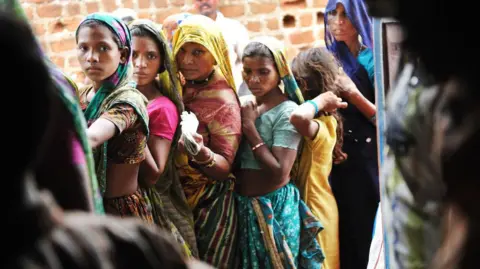[ad_1]
 Getty Images
Getty ImagesDecades of caste discrimination have contributed to India having higher levels of child stunting rates than across Sub-Saharan Africa, new research has revealed.
The two regions together are home to 44% of the world’s under-five population but account for about 70% of stunted children globally – a key indicator of malnutrition.
But, while both have made significant strides in recent years, India’s rate stands at 35.7%, with the average across Sub-Saharan Africa’s 49 countries at 33.6%.
A child is considered stunted when they fall short of the expected height for their age – a clear sign of critical nutritional gaps.
However, the study by Ashwini Deshpande (Ashoka University) and Rajesh Ramachandran (Monash University, Malaysia) found that focusing only on the height gap – or why Indian children are shorter than children in Sub-Saharan Africa – overlooks an important factor: the crucial role of social identity, especially caste, in child malnutrition in India.
The first 1,000 days of a child’s life, often called the “golden period”, are pivotal: by age two, 80% of the brain develops, laying the foundation for lifelong potential. In these early years, access to healthcare, good nutrition, early learning, and a safe environment profoundly shapes a child’s future.
India and Sub-Saharan Africa, both with rapidly growing middle classes, young populations and significant workforce potential, share longstanding comparisons. In 2021, the World Bank reported, “Sub-Saharan Africa and South Asia [including India] account for over 85% of the global poor,” underscoring similar challenges in poverty and development.
 Getty Images
Getty ImagesUsing official data, the authors looked at the most recent estimates of the stunting gaps between India and a sample of 19 countries in Sub-Saharan Africa.
Official data shows that more than 35% of India’s 137 million children under five are stunted, with over a third also underweight. Globally, 22% of children under five are stunted.
Then they examined six broad socially disadvantaged groups in India. Among them are adivasis (tribespeople living in remote areas) and Dalits (formerly known as untouchables), who alone comprise more than a third of the under-five population.
The economists found that children from higher-ranked, non-stigmatised caste groups in India stood at 27% – markedly lower than the Sub-Saharan African rate.
They also found that children from higher-ranking caste groups in India are some 20% less likely to experience stunting compared with those from marginalised groups, who occupy the lowest tiers of the caste hierarchy.
This conclusion remains significant even after accounting for factors like birth order, sanitation practices, maternal height, sibling count, education, anaemia and household socio-economic status.
This difference is despite seven decades of affirmative action, India’s caste system – a four-fold hierarchy of the Hindu religion – remains deeply entrenched.
“This should not be surprising given that children from better-off groups in India have access to more calories and face a better disease environment,” the authors say.
 Getty Images
Getty ImagesThe reasons behind high stunting rates among Indian children have sparked a complex debate over the years.
Some economists have argued that the differences are genetic – that Indian children are genetically disposed to lower heights.
Others believe that improved nutrition over generations has historically closed height gaps thought to be genetic.
Some studies have found that girls fare worse than boys and others just the opposite, using different global standards.
To be sure, stunting has decreased across social groups – a separate 2022 study found that improvements in health and nutrition interventions, household living conditions and maternal factors led to reduction in stunting in four Indian states. (More than half of India’s under-five children were stunted, according to a federal family health survey of 1992-93).
Children from marginalised groups like adivasis are likely to be more malnourished.
In Africa, the rate of stunting has also fallen since 2010, although the absolute number increased.
 Getty Images
Getty ImagesBut what is clear is that children from poor families, with less-educated mothers, or from marginalised groups, are especially vulnerable to stunting in India.
“The debate on the height gap between Indian and Sub-Saharan African children has resulted in overlooking the role of social identity, especially caste status,” the authors say.
“This is a crucial dimension to understanding the burden of child nutrition in India.”
The analysis uses data from demographic and health surveys. For India, it includes the latest data from 2019-21, and for Sub-Saharan Africa, it includes data from 19 countries with surveys from 2015 onwards. The dataset covers anthropometric – measurements related to the physical dimensions and composition of the human body- outcomes for 195,024 children under five in India and 202,557 children under five in Sub-Saharan Africa.
[ad_2]

